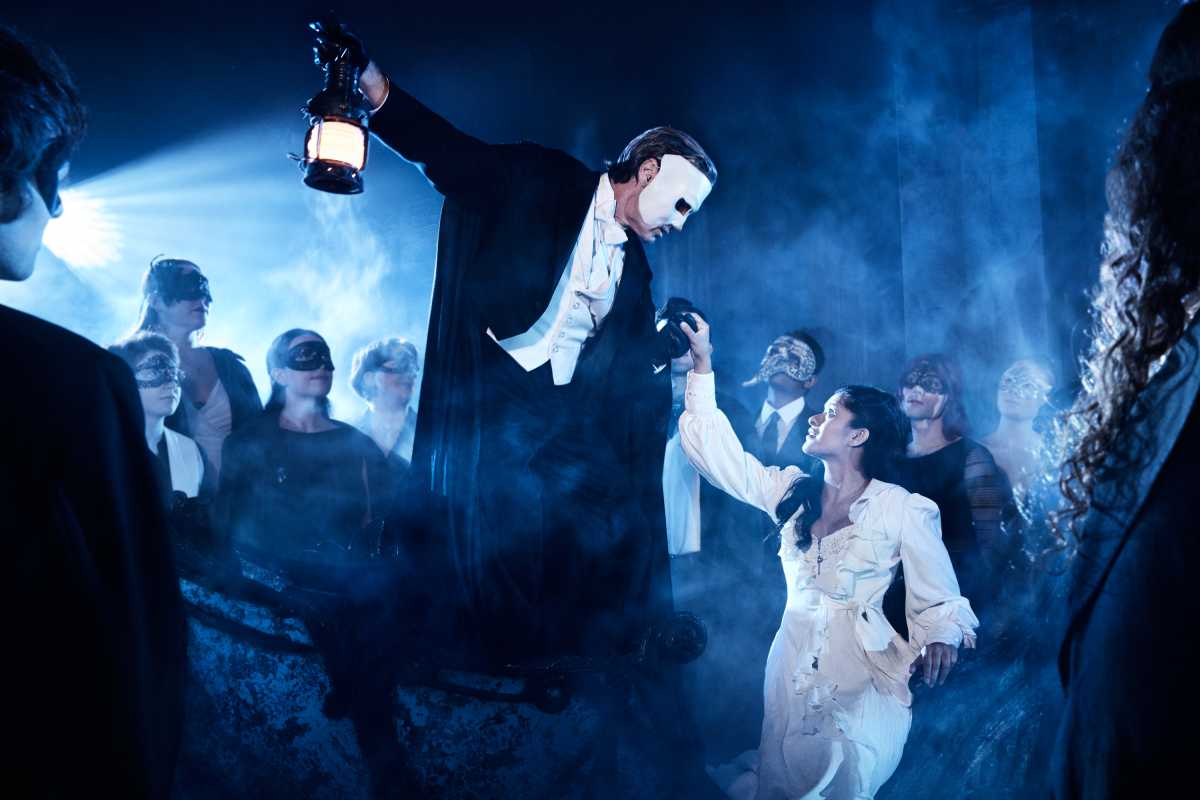Will the real Phantom please stand up? Hugh Panaro, Nik Walker, Jeff Kready, Clay Singer, Telly Leung and Kyle Scatliffe in “Masquerade.”
Photo by Oscar Ouk/provided
Broadway’s “The Phantom of the Opera” closed two years ago. Now the Phantom is back, subletting a vacant building in Midtown and throwing an immersive house party.
But this isn’t a revival of the long-running musical spectacular with music by Andrew Lloyd Webber and directed by the late Harold Prince. This is “Masquerade,” a two-hour, intermission-less adaptation of “Phantom” directed by Diane Paulus (“Pippin,” “Hair”) that tries to combine much of the “Phantom” narrative and score with the immersive theater experience of “Sleep No More.”
What results is not unlike an expensive, exclusive party in a carnival funhouse. While the original “Phantom” was derided by its detractors as a cheesy theme park attraction, “Masquerade” truly is a glorified one.
Tickets cost more than $200 and require a strict dress code: black, white, or silver cocktail attire, with masks mandatory (“Hide your face so the world will never find you”). Entry even requires a password. Once admitted, you check your bag, sip complimentary champagne, and hear a violinist play themes from the score.

Madame Giry, the ballet mistress from “Phantom,” welcomes the crowd and teaches a few simple dance steps for the song “Masquerade” before leading groups of 50 further into the building. Six audience “pulses” run simultaneously, each following a curated route. At the end, instead of a curtain call or Playbill, you get a card listing your cast and exit into a nightclub-like lounge where drinks are sold.
The logistics are impressive. Audiences wind through rooftops, graveyards, dressing rooms, and the Phantom’s lair, with alternate routes for bad weather. The spaces can be clever, even kitschy: Raoul and Christine sing on an actual rooftop (nifty but cheesy, especially when neighboring residents and office workers can watch for free). Christine’s visit to her father’s grave unfolds outdoors amid lanterns and fog. A carnival sequence dramatizes the Phantom’s origins with a new song, “Come and Marvel at the Freak.” Along the way, you gaze at opera posters, mannequins, the gondola, an elephant, and even the crystal chandelier, though its rise and descent feels more perfunctory than thrilling.

The trouble starts once the songs begin. Aside from the opening violinist, the music is prerecorded. The tracks sound flat in small rooms, stripping away the grandeur that once came from Broadway’s largest orchestra. Worse, the surviving numbers rarely integrate with the immersive sequences. They feel like interruptions rather than part of a continuous score, making you miss the seamless sung-through flow of the original.
In my time slot, the Phantom was played by Hugh Panaro, who played the role magnificently on Broadway two decades ago. He is one of multiple Phantoms rotating through the role each night, meaning which one you see is a matter of chance. Panaro still sings with authority but seems misplaced among a younger ensemble that treats the material as a light escapade rather than high drama.
It’s unrealistic to stage a labor-intensive narrative musical under these conditions. You can either stage “Phantom” in a theater or create a non-narrative funhouse party experience, but trying to do both at once satisfies neither. And really, who wants to dress up and then spend two hours traipsing staircases just to hear bits and pieces of “Phantom” with prerecorded tracks?
As an event, “Masquerade” intrigues. As a social outing, it entertains. But as theater, it’s hollow. What’s on offer is not “The Phantom of the Opera” but its glossy, emptied-out cousin. The title says it all: A masquerade.
For more information, visit masqueradenyc.com.
→ Continue reading at amNY
